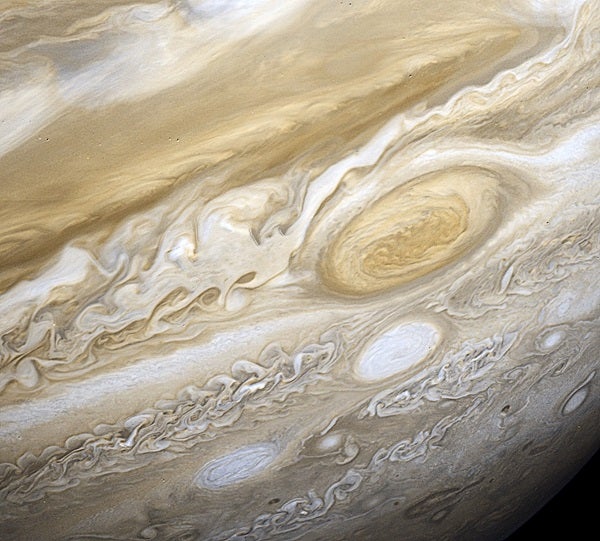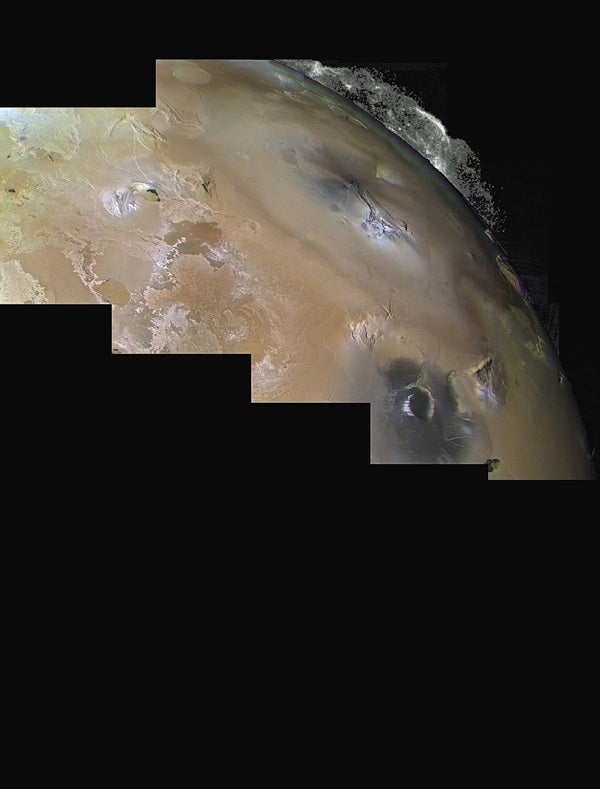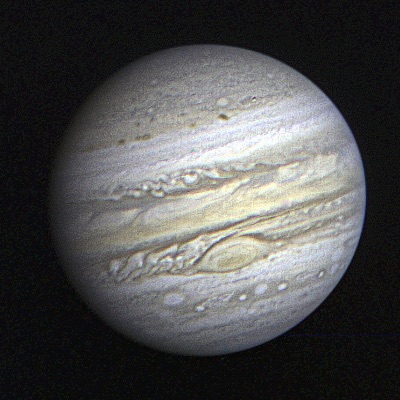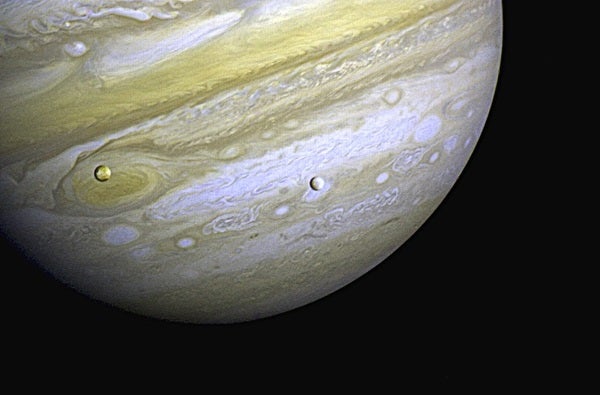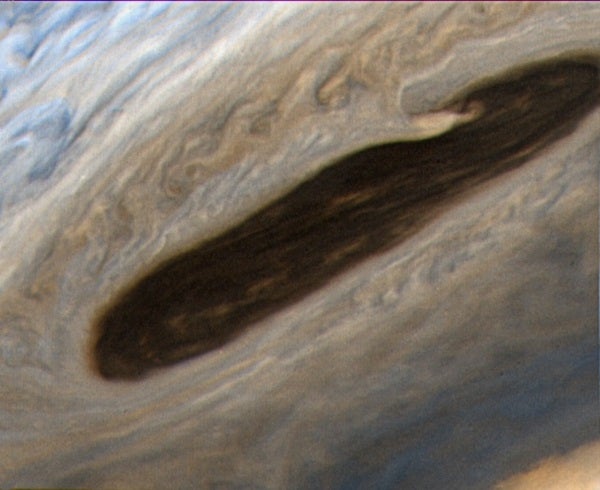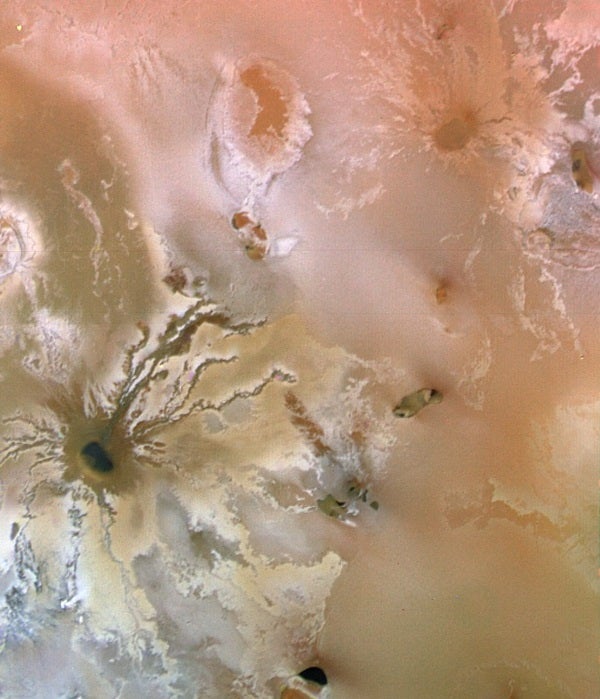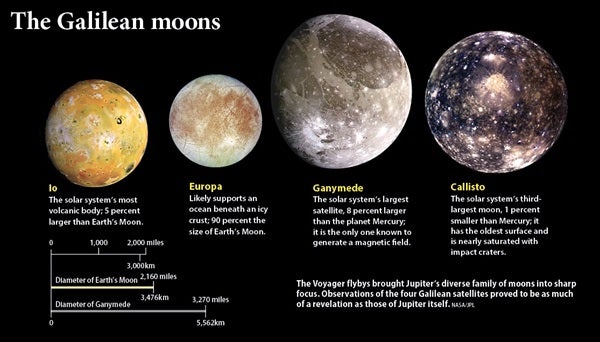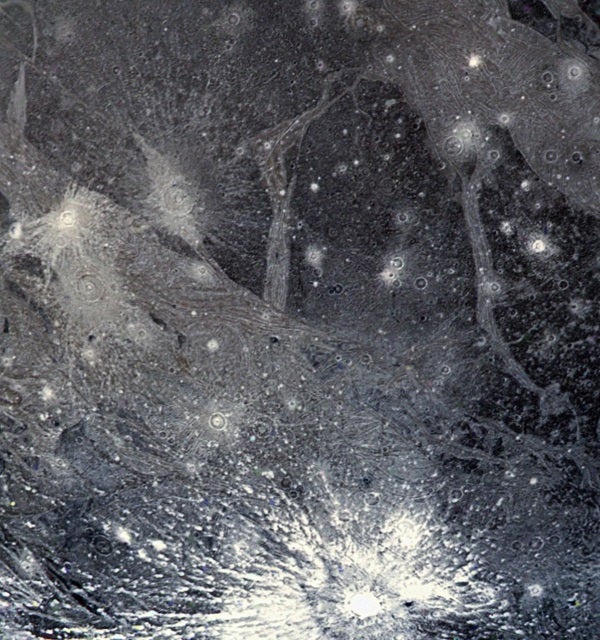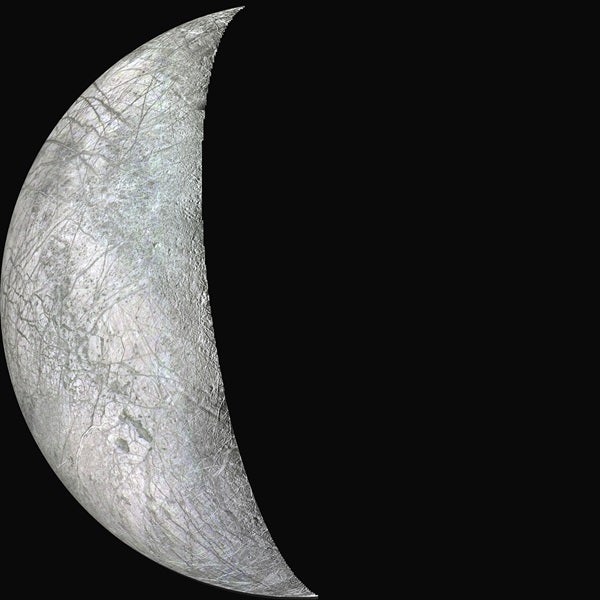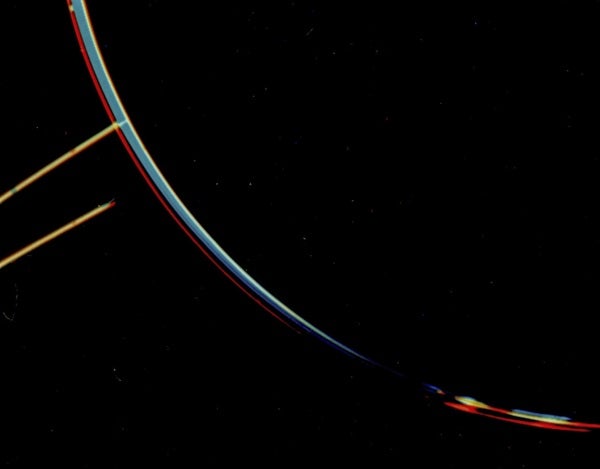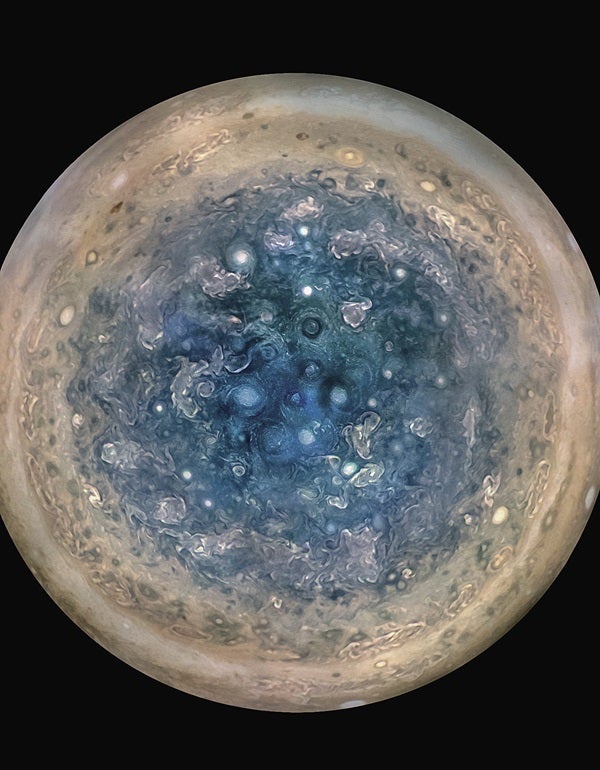For centuries, humanity could view this giant world only through ground-based telescopes. But in 1973 and 1974, respectively, the Pioneer 10 and 11 spacecraft raced past the planet, providing the first close-up images of its stormy atmosphere, probing its internal structure, and charting its intense radiation belts and magnetic field. The Pioneer probes blazed a trail for further exploration of the outer solar system. Even as scientists reveled in the data the probes returned, NASA already was working on a far more ambitious encore.
“It’s been a remarkable journey,” says Voyager project scientist Ed Stone at the California Institute of Technology in Pasadena. “We keep discovering things nobody knew we were going to discover.” He says both spacecraft may be able to return measurements from a single science instrument until 2030 if their power sources — called radioisotope thermoelectric generators — hold out as expected.
Encounter with Jove
On January 6, 1979, Voyager 1 was 36 million miles (58 million kilometers) from Jupiter and two months from its closest approach. Views of the planet’s cloudy, banded disk already exceeded the best images from Earth. Among other assignments, the probe began accumulating a time-lapse movie by taking images every 10 hours, one for each Jupiter rotation.
By early February, the resolution and image quality were comparable to the best pictures returned by the Pioneers. From that point on, Jupiter would be seen as never before.
When viewed from Earth through a small telescope, the planet’s atmosphere shows alternating bright white zones and darker brown belts. These are the visible manifestations of east-west jet streams that alternate direction from the equator to the poles and carry oval-shaped weather systems of all sizes.
The planet’s largest feature, a vast southern storm called the Great Red Spot, had been observed continuously from Earth for 150 years. But now, for the first time, scientists could study its rotation and watch it interact with neighboring features. Large enough to hold a pair of Earth-sized planets, the Great Red Spot rolls between two jet streams and completes a rotation in about six days. It spins counterclockwise, the opposite direction as hurricanes in Earth’s Southern Hemisphere, classifying it as a high-pressure system. Its cloud tops extend nearly 5 miles (8km) above neighboring layers. Although winds whip around its periphery at 425 mph (680 km/h), the interior is calm. Its size and position vary slightly, and long-term ground-based monitoring shows that the longest-lived storm known to science is shrinking steadily.
Amy Simon at NASA’s Goddard Space Flight Center in Greenbelt, Maryland, leads a team studying Jupiter with the Hubble Space Telescope. The observations show the storm’s long axis is half what was reported in the 1880s and about 30 percent smaller than during the Voyager flybys. And since 2014, the Great Red Spot has turned an unusually intense shade of orange.
In 1998, two of three 60-year-old white oval storms in a cloud band south of the Great Red Spot merged, and in early 2000, the third oval joined them. The resulting weather system, named Oval BA, is about half the size of the Great Red Spot and persists today. In August 2005, amateur astronomers noticed it was acquiring a reddish color. The hue gradually deepened; by 2006, the storm was nicknamed “the Little Red Spot” and “Red Spot Jr.”
Yet despite the Voyager probes and later missions, vital questions about Jupiter’s atmosphere remain. Why are the jet streams and large storms stable for so long? What’s the energy source for the jets? And do the winds continue into the planet’s interior?
Diving into Jupiter
The top of Jupiter’s atmosphere consists of haze layers formed by complex hydrocarbons like ethane, ethylene, and acetylene. These chemicals assemble from the fragments of methane molecules broken apart by solar UV, a process similar to how smog forms in Earth’s atmosphere. About 25 miles (40km) deeper, the pressure approaches 60 percent of that at Earth’s surface (1 bar), but the temperature is only –193° F (–125° C). A deck of bright white clouds formed by ammonia ice crystals occupies this level.
Minute frequency changes in spacecraft radio signals allow scientists to map the structure of Jupiter’s gravitational field; this enables them to develop models of what lies beneath the clouds. Pressures and temperatures increase steadily, but the hydrogen atmosphere simply grows denser and hotter with depth until, hundreds of miles beneath the clouds, molecular hydrogen starts to resemble a hot liquid. At depths 10 times greater, only 20 percent of the way to Jupiter’s center, pressures approach a million bars, and temperatures soar to 10,000° F (5,700° C) — nearly as hot as the Sun’s surface. Here the interior transforms into a more exotic substance called liquid metallic hydrogen, an electrically conductive soup of protons and electrons that makes up most of Jupiter’s mass.
Some 28,000 miles (45,000km) farther down, about 80 percent of the way to the planet’s center, the composition may change to a mix of water, methane, and ammonia at enormous temperatures and pressures. Another 4,400 miles (7,000km) down, and we’re 10 percent from the center; the pressure rises to around 40 million bars and the temperature to some 40,000° F (22,000° C). At this point, Jupiter’s composition may gradually morph into a dense core, perhaps containing up to 20 Earth masses in a mix of rock and iron that may also include water, methane, and ammonia.
At these pressures, dense materials may become soluble in liquid hydrogen, some scientists suggest. This means Jupiter’s original core may have dissolved partially or completely away, its high-density materials dispersed throughout a larger portion of the planet. One of the main goals of NASA’s Juno mission, which has been orbiting the planet since July 2016, is to answer the many remaining questions about how the solar system’s largest world is put together. (See “Under the veil,” above.)
Magnetic tango
Like Earth, Jupiter generates a magnetic field, which at the cloud tops is about 15 times stronger than our planet’s. The field traps, stores, and controls the flow of charged particles inside it, forming a vast, comet-shaped bubble — called a magnetosphere — that shields the planet from direct exposure to the solar wind. Pressure from the solar wind pushes the Sun-facing side into a rounded bow shock that slows and deflects most of the incoming charged particles in much the same way that water flows around the bow of a moving ship. The opposite side tapers into an immense magnetotail whose farthest portions wave and flap like the tattered end of a windsock.
Between February 28 and March 2, 1979, the magnetosphere seemed to be playing hard to get with the approaching Voyager 1. The solar wind was gusty, producing unusually strong and variable pressures that pushed the bow shock closer to the planet. When the wind eased, the bow shock re-expanded. Pioneers 10 and 11 made their crossings 50 diameters from Jupiter, but Voyager 1 crossed it five times, the last at scarcely half that range (28 diameters).
On March 5, the spacecraft made its closest approach, passing within 128,400 miles (206,700km) of Jupiter’s cloud tops, barely one-third the distance at which Voyager 2 would pass July 9. Scientists selected this path so they could measure a hypothesized electrical circuit connecting Jupiter and its moon Io, and it took Voyager 1 deep into the most hazardous radiation belts in the solar system. Based on measurements from the Pioneers, the Voyager design included shielding that hardened sensitive electronics to the bombardment of high-energy electrons, protons, and ions stored in Jupiter’s equivalent of Earth’s Van Allen Belts. But an unprotected human passenger riding aboard Voyager 1 during closest approach would have received a thousand times the lethal radiation dose.
Four new worlds
An extraordinary planet deserves extraordinary moons, and Jupiter’s four big satellites do not disappoint. Discovered by Galileo Galilei in 1610, they are Io, Europa, Ganymede, and Callisto (in order of distance from the planet). Ganymede, the largest and most massive moon in the solar system, is slightly bigger than Mercury, while Callisto is nearly the planet’s diameter. Both Io and Europa are roughly the size of Earth’s Moon.
The moons’ complexity and individuality, which scientists hardly suspected despite centuries of telescopic observations, proved a major surprise of the Voyager missions. Reporting their results in the journal Science three months after the Voyager 1 encounter, the imaging team noted that the large moons do not closely resemble either the planets in the inner solar system or one another. “The sense of novelty,” they wrote, “would probably not have been greater had we explored a different solar system.”
“They’re quite distinct,” says Stone, “and I think the one thing we have learned is that nature is remarkably diverse, and you don’t see replicas. Each body seems to have its own life history written on the surface and in its interior.”
There had long been hints that the big moons might be doing something interesting. Galileo’s 17th-century plots showed that Europa and Io always meet up on the side of Jupiter exactly opposite from where Europa and Ganymede do. In the 7.15 days it takes Ganymede to go around Jupiter once, Europa orbits twice and Io four times. This 1:2:4 resonance forces the moons’ orbits to maintain a slight eccentricity, which in turn causes their bodies to flex slightly due to tides raised by Jupiter’s gravity. Just as repeatedly bending a paper clip warms up the metal, this forced flexing warms the interiors of Jupiter’s big moons.
On March 8, as Voyager 1 raced out of the Jupiter system, its camera captured a routine navigation image of a crescent Io as part of a program to refine knowledge of the spacecraft’s trajectory. The next day, JPL engineer Linda Morabito enhanced this image to locate background stars and uncovered another crescent shape on Io’s sunlit limb. It looked like the edge of another satellite peeking out from behind Io, but scientists determined that an unknown satellite so large would have been detectable from Earth. “No one understood what they were seeing, reinforcing the degree of difficulty associated with interpreting this image,” she later wrote.
Scientists now know of at least 150 active volcanoes on Io. Some of them blast umbrella-shaped plumes containing sodium, potassium, sulfur, sulfur dioxide, and more to altitudes as high as 310 miles (500km). Some of the ejecta falls back to paint Io’s terrain in garish hues, and the rest forms a thin, distended atmosphere around the moon. Particle interactions ionize some of these atoms, and they then become swept up in Jupiter’s fast-moving magnetic field, which rotates with the planet’s 10-hour rotation. “About a ton per second of that material is picked up by the jovian magnetic field, and that mass of stuff inflates the Jupiter magnetosphere to about twice the size it should be,” Stone says.
The ionized gas spreads along Io’s orbit to form a doughnut-shaped cloud called the Io plasma torus. Some of the heavy ions in the torus migrate outward, and their pressure supersizes the magnetosphere. As Io moves through the torus, it continuously generates an electrical current that flows along a conduit, called the Io flux tube, linked to Jupiter’s upper atmosphere. Two billion kilowatts flow through the flux tube, comparable to the average global power consumption on Earth. The Voyager 1 team deliberately tried to pass through the tube, but the material around Io shifted its position from what was expected, and the spacecraft instead flew alongside it.
While imaging from Earth in 1993, Connerney and his colleagues discovered a spot of infrared emission in Jupiter’s polar atmosphere. The glow tracked with Io in its orbit and arose from energy coursing down the flux tube. But Io isn’t alone in this regard. In 2002, Hubble imaged Io’s spot in the UV and found two more glows from Europa and Ganymede, showing they generate their own flux tubes. “The system is highly coupled and connected, where the magnetic fields and the particles are all interacting with the moons,” Stone says. And the phenomenon isn’t unique to Jupiter. In 2011, scientists identified a UV spot associated with the active moon Enceladus in images from the Cassini mission orbiting Saturn.
The outer trio
Europa, the next moon out from Jupiter, couldn’t be more different from its siblings. Low-resolution images from Voyager 1 showed a bright surface of frozen water with no discernible craters, along with hints of dark linear features. Voyager 2 passed much closer to Europa on July 9, and its images revealed frozen plains crisscrossed by dark streaks, giving it the look of a cracked egg. Europa’s surface is the smoothest in the solar system. Features display so little topographical relief that imaging team member Larry Soderblom compared the moon to a billiard ball. Later that year, the scientists who explained the heating of Io suggested that tidal flexing of Europa could provide enough heat to sustain an ocean beneath its icy shell, which is widely thought to be 10 to 15 miles (16 to 24km) thick. The ocean itself may be at least 30 miles (48km) deep, or more than 10 times the average depth of Earth’s seas.
In fact, several lines of evidence now support the presence of briny global oceans within Europa, Ganymede, and Callisto, each containing more water than Earth’s seas. NASA’s Galileo spacecraft, which in 1995 became the first to orbit Jupiter, flew close to these moons and found that Jupiter’s rotating magnetic field induces currents in electrically conducting layers within them. These currents, in turn, generate secondary magnetic fields Galileo could detect. Europa’s induced response matches what researchers would expect for a salty subsurface ocean many miles thick. And different teams using Hubble in 2012 and 2016 discovered tantalizing evidence that Europa occasionally erupts plumes of water vapor reaching heights of 125 miles (200km), suggesting the icy shell may be quite thin in some locations.
The Galileo mission revealed in 1996 that Ganymede generates its own permanent magnetic field, the only moon in the solar system known to do so, and therefore makes its own miniature magnetosphere. This complicates the interpretation of its induced field, but recent models, as well as Hubble observations of Ganymede’s aurorae, suggest the interior contains shells of different phases of water ice separated by salty seas.
Callisto, the farthest of Jupiter’s big moons, hosts the solar system’s most heavily cratered and geologically ancient surface. Its terrain is nearly saturated with bright impact craters. The largest visible feature, named Valhalla, resembles a bull’s-eye about 2,200 miles (3,600km) across, the frozen remnant of a giant impact. Galileo spacecraft observations indicate the presence of a salty, subsurface global ocean despite little tidal heating at Callisto now. Perhaps ammonia and other contaminants lower the freezing point enough for a liquid layer to survive.
Opening act
The Jupiter flybys mark the first chapter in the Voyagers’ exploration of the outer solar system. They provided new views of an enormous, complex, and dynamic atmosphere that is still far from understood. They explored a vast magnetosphere loaded with particles from its moons, especially Io, and intimately connected to them. Close-ups of unique new worlds uncovered incredible properties, including the first example of active extraterrestrial volcanism and the first clues that frozen moons could sport internal seas. Further discoveries included a faint ring of dust extending 80,000 miles (129,000km) from the planet’s center, and two new moons, Metis and Adrastea, orbiting just beyond it. The probes also found a third satellite, Thebe, in a more distant orbit, though still well inside Io’s.
With Jupiter now in the rearview mirror, Voyager scientists could begin digging deeper into the data — and wondering what awaited them at their next destination, Saturn.

